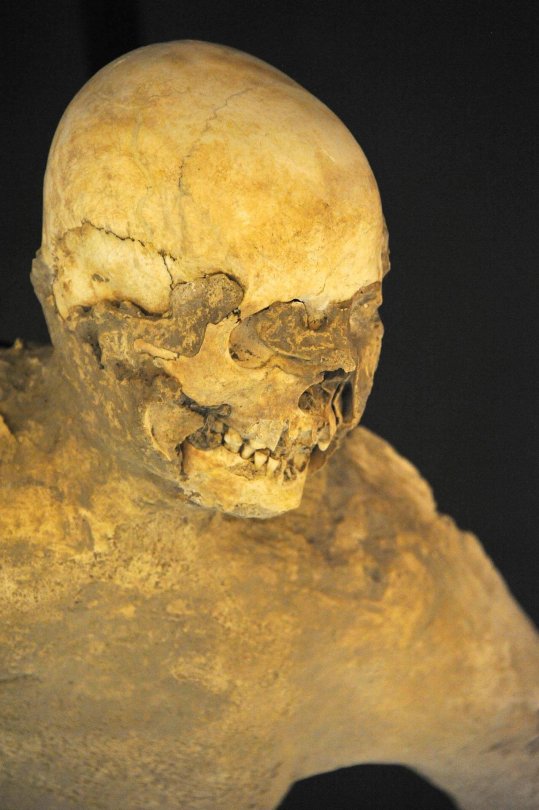#genome
Text
This just in, starfish are a radially symmetrical head with a stomach.
God I love echinoderms
If you told someone that there’s an entire group of animals that develop butt first as embryos are born bilateral but then grow a radially symmetrical head like a cancer in their side that then bursts out and lives as a completely separate organism from its birth form and moves via hydraulic systems…
They wouldn’t believe you. Yet one of the most beloved cartoon characters is one of them.
#biology#genomics#genome#genomes#genome sequencing#evolutionary biology#echinoderm#starfish#asteroidea#bilateria#Deuterostome#Deuterostomia
5K notes
·
View notes
Text
This is maybe an odd thing to put on a good news/reasons for hope blog, but I've also had people tell me that they find this info really, genuinely comforting, so I'm putting it up.
Also, further understanding could do a ton to advance medicine, esp. re: allergies, autoimmune diseases, and depression. You can read more about this at the link.
"More than half of your body is not human, say scientists.
Human cells make up only 43% of the body's total cell count. The rest are microscopic [co-contributors].
Understanding this hidden half of ourselves - our microbiome - is rapidly transforming understanding of diseases from allergy to Parkinson's.
The field is even asking questions of what it means to be "human" and is leading to new innovative treatments as a result.
"They are essential to your health," says Prof Ruth Ley, the director of the department of microbiome science at the Max Planck Institute, "your body isn't just you."
No matter how well you wash, nearly every nook and cranny of your body is covered in microscopic creatures.
This includes bacteria, viruses, fungi and archaea (organisms originally misclassified as bacteria). The greatest concentration of this microscopic life is in the dark murky depths of our oxygen-deprived bowels.
Prof Rob Knight, from University of California San Diego, told the BBC: "You're more microbe than you are human."
Originally it was thought our cells were outnumbered 10 to one.
"That's been refined much closer to one-to-one, so the current estimate is you're about 43% human if you're counting up all the cells," he says.
But genetically we're even more outgunned.
The human genome - the full set of genetic instructions for a human being - is made up of 20,000 instructions called genes.
But add all the genes in our microbiome together and the figure comes out between two and 20 million microbial genes.
Prof Sarkis Mazmanian, a microbiologist from Caltech, argues: "We don't have just one genome, the genes of our microbiome present essentially a second genome which augment the activity of our own.
"What makes us human is, in my opinion, the combination of our own DNA, plus the DNA of our gut microbes."
It would be naive to think we carry around so much microbial material without it interacting or having any effect on our bodies at all.
Science is rapidly uncovering the role the microbiome plays in digestion, regulating the immune system, protecting against disease and manufacturing vital vitamins.
Prof Knight said: "We're finding ways that these tiny creatures totally transform our health in ways we never imagined until recently."
It is a new way of thinking about the microbial world. To date, our relationship with microbes has largely been one of warfare.
-via BBC News, April 10, 2018
#cw germaphobia#germaphobia#bacteria#viruses#fungi#archaea#dna#genome#genetics#biology#human biology#public health#biodiversity#technically it is biodiversity!#increasingly we learn that your own body needs to be biodiverse to even form properly#some of the studies we have on this are literally kinda mindblowing#also microbiotics is the next huge frontier in treating depression and anxiety#(well they're tied for the next huge frontier with psychedelics probably)#good news#arguably lol#hope
387 notes
·
View notes
Text
According to scientists the interbreeding with ancient Denisovans led to a slight variation in zinc regulation resulting in modern day mental health issues.
#DNA#genome#Homo sapiens#Denisovans#mental health#depression#modern humans#ancient#history#ancient origins
56 notes
·
View notes
Text
First Pompeiian human genome sequenced

The first successfully sequenced human genome from an individual who died in Pompeii, Italy, after the eruption of Mount Vesuvius in 79 CE is presented this week in a study published in Scientific Reports. Prior to this, only short stretches of mitochondrial DNA from Pompeiian human and animal remains had been sequenced.
Gabriele Scorrano and colleagues examined the remains of two individuals who were found in the House of the Craftsman in Pompeii and extracted their DNA. The shape, structure, and length of the skeletons indicated that one set of remains belonged to a male who was aged between 35 and 40 years at the time of his death, while the other set of remains belonged to a female aged over 50 years old. Read more.
583 notes
·
View notes
Link
A new paper in Molecular Biology and Evolution provides interesting new evidence about the evolution of North American wolves, which has been a subject of debate among conservationists and taxonomists.
84 notes
·
View notes
Text

"No one is in charge. And honestly, that makes it even cooler."
-- Adam Savage
"The idea of an ordered and elegant universe is a lovely one. One worth clinging to. But you don’t need religion to appreciate the ordered existence. It’s not just an idea, it’s reality. We’re discovering the hidden orders of the universe every day. The inverse square law of gravitation is amazing. Fractals, the theory of relativity, the genome: these are magnificently beautiful constructs."
-- Adam Savage
#Adam Savage#universe#ordered universe#gravitation#gravity#fractals#fractal#theory of relativity#genome#science#science is amazing#religion is a mental illness
8 notes
·
View notes
Text
Specter being Blue Angel's Number 1 Fan, but it actually him Being that
Ryoken walks in on him watching a live duel of her as he roaring every second that she won a duel.
He has all of the Merchandise.
He has and will tell you about the Lore of Blue Angel. Ask Genome for that
10 notes
·
View notes
Link
Scientists from the University of Maryland have developed PRAWNS, a scalable and efficient tool for multi-genome analysis. With the unprecedented number of complete and nearly complete genomes being accessible, researchers interested in understanding the genomic basis of phenotypes, such as antibiotic resistance in bacteria, require computational tools capable of performing multiple genome comparisons efficiently. However, currently available computational tools do not scale well in terms of the number of genomes. PRAWNS was developed to fill the gap in the currently available toolbox for understanding genotype-phenotype associations, and this is achieved by defining metablocks, a concise set of genomic features, and pairwise relationships between them.
Continue Reading
57 notes
·
View notes
Text
DNA sounds like Mr crabs laugh to me.
How am I meant to read
aaaccccctc actgtgccct ttgaatacta cagaataagg aaggttaagg ttgaattctg gccctgctcc ccaatcaccc agggtgacag gggagtgggc tccactgctg ttattctaga tgataacttt gtaacaaagg ccaatgccct aacctatgac ccctatgtaa actactcctc ccgccatacc ataacccagc ccttctccta ccactcccgg tactttaccc cgaaacctgt ccttgatggg acaatcgatt acttccaacc caataacaaa
And not hear this mf

19 notes
·
View notes
Text
Yet another scene I completely forgot about until this rewatch







Spectre: I kinda wanna meet my Ignis.
Genome: No you don’t.
Spectre: ...no I don’t.
Okay, there’s like a split second pause, but in that split second:

Maybe it’s just the lighting (or his weird eyebrows), but he looks pissed.
I’ll admit, I’m pretty sold on the idea that he wanted to meet Earth now. It’s at the very least implied, and a shame he never got to on-screen.
#yugioh#ygo#yugioh vrains#ygo vrains#vrains#spectre#spectre vrains#knights of hanoi#earth ignis#earth vrains#genome vrains#genome
23 notes
·
View notes
Text
This species has unique sets of microchromosomes. The genome alters itself when microchromosomes are lost when a creature ages and develops but the microchromosomes only remain in the reproductive organs.
This evolved in vertebrates being able to clone their genome in reproduction and to turn off certain genes in cells.
This creature is the origin of the complex brain, sensory organs the jaw, the limbs, and a greater number of switches that turn genes on/off.
This paper is on Hagfish phylogenomics and gene family evolution being the origin of WGD or a sister group of vertebrates to the first to have multiple sets of chromosomes.
Whole-genome duplication (WGD) evolved in vertebrates during the late Cambrian and early Ordovician periods.
We calculated the likelihood of gene duplication and loss patterns under the competing R1 and R2 hypotheses.
#biology#chromosomes#vertebrates#evolution#hagfish#genome#evolutionary ancestor#ordovician#science party#scientific research
4 notes
·
View notes
Text
A protein found in human sweat may protect against Lyme disease
New Post has been published on https://thedigitalinsider.com/a-protein-found-in-human-sweat-may-protect-against-lyme-disease/
A protein found in human sweat may protect against Lyme disease


Lyme disease, a bacterial infection transmitted by ticks, affects nearly half a million people in the United States every year. In most cases, antibiotics effectively clear the infection, but for some patients, symptoms linger for months or years.
Researchers at MIT and the University of Helsinki have now discovered that human sweat contains a protein that can protect against Lyme disease. They also found that about one-third of the population carries a genetic variant of this protein that is associated with Lyme disease in genome-wide association studies.
It’s unknown exactly how the protein inhibits the growth of the bacteria that cause Lyme disease, but the researchers hope to harness the protein’s protective abilities to create skin creams that could help prevent the disease, or to treat infections that don’t respond to antibiotics.
“This protein may provide some protection from Lyme disease, and we think there are real implications here for a preventative and possibly a therapeutic based on this protein,” says Michal Caspi Tal, a principal research scientist in MIT’s Department of Biological Engineering and one of the senior authors of the new study.
Hanna Ollila, a senior researcher at the Institute for Molecular Medicine at the University of Helsinki and a researcher at the Broad Institute of MIT and Harvard, is also a senior author of the paper, which appears today in Nature Communications. The paper’s lead author is Satu Strausz, a postdoc at the Institute for Molecular Medicine at the University of Helsinki.
A surprising link
Lyme disease is most often caused by a bacterium called Borrelia burgdorferi. In the United States, this bacterium is spread by ticks that are carried by mice, deer, and other animals. Symptoms include fever, headache, fatigue, and a distinctive bulls-eye rash.
Most patients receive doxycycline, an antibiotic that usually clears up the infection. In some patients, however, symptoms such as fatigue, memory problems, sleep disruption, and body aches can persist for months or years.
Tal and Ollila, who were postdocs together at Stanford University, began this study a few years ago in hopes of finding genetic markers of susceptibility to Lyme disease. To that end, they decided to run a genome-wide association study (GWAS) on a Finnish dataset that contains genome sequences for 410,000 people, along with detailed information on their medical histories.
This dataset includes about 7,000 people who had been diagnosed with Lyme disease, allowing the researchers to look for genetic variants that were more frequently found in people who had had Lyme disease, compared with those who hadn’t.
This analysis revealed three hits, including two found in immune molecules that had been previously linked with Lyme disease. However, their third hit was a complete surprise — a secretoglobin called SCGB1D2.
Secretoglobins are a family of proteins found in tissues that line the lungs and other organs, where they play a role in immune responses to infection. The researchers discovered that this particular secretoglobin is produced primarily by cells in the sweat glands.
To find out how this protein might influence Lyme disease, the researchers created normal and mutated versions of SCGB1D2 and exposed them to Borrelia burgdorferi grown in the lab. They found that the normal version of the protein significantly inhibited the growth of Borrelia burgdorferi. However, when they exposed bacteria to the mutated version, twice as much protein was required to suppress bacterial growth.
The researchers then exposed bacteria to either the normal or mutated variant of SCGB1D2 and injected them into mice. Mice injected with the bacteria exposed to the mutant protein became infected with Lyme disease, but mice injected with bacteria exposed to the normal version of SCGB1D2 did not.
“In the paper we show they stayed healthy until day 10, but we followed the mice for over a month, and they never got infected. This wasn’t a delay, this was a full stop. That was really exciting,” Tal says.
Preventing infection
After the MIT and University of Helsinki researchers posted their initial findings on a preprint server, researchers in Estonia replicated the results of the genome-wide association study, using data from the Estonian Biobank. These data, from about 210,000 people, including 18,000 with Lyme disease, were later added to the final Nature Communications study.
The researchers aren’t sure yet how SCGB1D2 inhibits bacterial growth, or why the variant is less effective. However, they did find that the variant causes a shift from the amino acid proline to leucine, which may interfere with the formation of a helix found in the normal version.
They now plan to investigate whether applying the protein to the skin of mice, which do not naturally produce SCGB1D2, could prevent them from being infected by Borrelia burgdorferi. They also plan to explore the protein’s potential as a treatment for infections that don’t respond to antibiotics.
“We have fantastic antibiotics that work for 90 percent of people, but in the 40 years we’ve known about Lyme disease, we have not budged that,” Tal says. “Ten percent of people don’t recover after having antibiotics, and there’s no treatment for them.”
“This finding opens the door to a completely new approach to preventing Lyme disease in the first place, and it will be interesting to see if it could be useful for preventing other types of skin infections too,” says Kara Spiller, a professor of biomedical innovation in the School of Biomedical Engineering at Drexel University, who was not involved in the study.
The researchers note that people who have the protective version of SCGB1D2 can still develop Lyme disease, and they should not assume that they won’t. One factor that may play a role is whether the person happens to be sweating when they’re bitten by a tick carrying Borrelia burgdorferi.
SCGB1D2 is just one of 11 secretoglobin proteins produced by the human body, and Tal also plans to study what some of those other secretoglobins may be doing in the body, especially in the lungs, where many of them are found.
“The thing I’m most excited about is this idea that secretoglobins might be a class of antimicrobial proteins that we haven’t thought about. As immunologists, we talk nonstop about immunoglobulins, but I had never heard of a secretoglobin before this popped up in our GWAS study. This is why it’s so fun for me now. I want to know what they all do,” she says.
The research was funded, in part, by Emily and Malcolm Fairbairn, the Instrumentarium Science Foundation, the Academy of Finland, the Finnish Medical Foundation, the Younger Family, and the Bay Area Lyme Foundation.
#000#Analysis#Animals#antibiotic#Antibiotics#antimicrobial#approach#Bacteria#Biological engineering#Biology#Broad Institute#Cells#communications#data#Delay#Disease#disruption#engineering#eye#factor#fatigue#Finland#Foundation#Full#genetic#Genetics#genome#growth#how#human
2 notes
·
View notes
Text

⚠️random chimp event⚠️
aka: i redid saiph’s ref sheet for portfolio stuff
#ff9#saiph my friend saiph#ff9 oc#ffix#genome#final fantasy#final fantasy oc#art#oc art#my son he is siiiiiiiick
18 notes
·
View notes
Text
A latest genetic study has put forth stunning revelations of the world’s oldest Alpine celebrity, Ötzi the Iceman, uncovering surprising attributes of the famous mummy – dark skin and eyes and male pattern baldness.
59 notes
·
View notes
Text
Naka No hito genome
Theories!!
naka no hito author just reported in twitter there are more chapters and there will be update although its delayed several times hopefully it will be updated soon..
So why not make some crazy theories as there is lots of thoery making elements and scopes for this amazing but underrated manga but literally the manga plot,drawing is soo cool 🫶.
Notes: 🕳️There are 8 main characters centering them the story takes place.

this is a part from the anime we see that this pic contains yuko and akatsuki in the lab. But if we notice, yuzu is also at the back the short haired one. In the anime pic we get a glimpse of their color of clothes where akki's cloth is turquoise and yuko's clothe is pink. Throughout the manga use of these two colors were noticeable not to mention it was used in the most vital places as if it is indicating something . in the one s within color matters in reffering to the characters
Like each characters have their own colors
But isnt pink like karin's theme color??!!. why is yuko wearing pink???? 💀💀not to mention this was meant to show that yuko and akki are wearing certain colors in that photo and the crazy part is this doesnt end here!
Akki ' cars that he always carries also contains these two color like whaaA?!
Ayo when i noticed this i kinda thought wasnt a big deal but after rereading the manga upto ch48 i found many unwxplained hints.
But im like serious karin is probabaly the character with the least character development she basically does nothing throughout the manga except for yuzu senaping and crying after brother despite being the main character. Ik yall will say same goes for makino being pretty alid back and thats also true like makino knows something abt the whole situation and if u notice makino and anya both seems to care wayy to much abt akatsuki and is close to him for some reason.
So im thinking that there has to be some plot regarding anya and makino and karin.
Mainly karin cause she is absoloutely laid back the whole series and does nothing even her backgroung isnt anything woth mentioning its as if her brother is more of an important character then herself.which is just not it.
these are the pics of manga makes me wonder if karin is somehow related to yuko and yuzu




The way karin stands is quite simillar to yuko. And yuko is mostly shown when karin appears.there is more to it but now im tired tell me your thoughts about it..
#Nakano hito#The ones within#Genome#Theories#Karin sarayashiki#Manga#Osora#YuzuAnd karin#Akastuki iride
1 note
·
View note
Link
Around 100 million years ago, a group of land-dwelling turtles took to the oceans, eventually evolving into the sea turtles that we know today. However, the genetic foundations that have enabled them to thrive in oceans throughout the world have remained largely unknown. In research recently published in the Proceedings of the National Academy of Sciences, an international team of 48 researchers led by the University of Massachusetts Amherst in collaboration with the Leibniz Institute for Zoo and Wildlife Research and the Vertebrate Genome Project revealed an incredibly detailed genetic map of two species—green and leatherback turtles—which is packed with surprises that might hold the key to their survival in a rapidly changing world.
96 notes
·
View notes